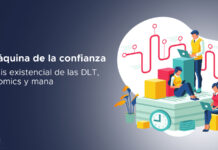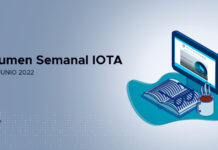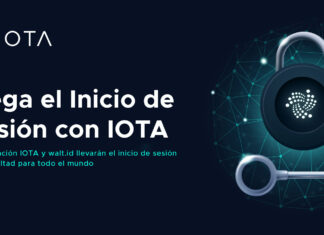 2019 came to our door and each year that passes it becomes more evident that we need to achieve a change of habits regarding to our economy, our way of consuming and sharing resources if we want to preserve a good life and the place where we are living. This task will not be easy, but it is necessary. We could go on to list all the things that urgently need a change of consciousness on our part, but we will not concentrate on everything in this article. I just know that future generations need us to become aware and start doing something. Today we are going to see how new technologies but especially IOTA can be part of the solution to solve some of the problems we will see below.
2019 came to our door and each year that passes it becomes more evident that we need to achieve a change of habits regarding to our economy, our way of consuming and sharing resources if we want to preserve a good life and the place where we are living. This task will not be easy, but it is necessary. We could go on to list all the things that urgently need a change of consciousness on our part, but we will not concentrate on everything in this article. I just know that future generations need us to become aware and start doing something. Today we are going to see how new technologies but especially IOTA can be part of the solution to solve some of the problems we will see below.
Gabriela Jara
Content Coordinator & Writer
IOTA Hispano
Let’s review some facts
- Our current economy leads us to a huge disparity between those who have the most and those who do not. Our economy always depends on centralized entities, there’s always a middle man, to whom we must provide personal information with which they then profit. We don’t own our data.
- Scientists claim that if we do nothing global warming will lead us to extinction, (Yes, I don’t want to be extremist, but it’s true), while we could lose an enormous amount of species due to man-made deforestation or climate change. Glaciers began to melt several times faster which could cause a drastic change in the water course.
Our economy is still governed by fuel fossils since the discovery of oil in 1859. This discovery brought with it a great revolution and much improvement in people’s quality of life from the arrival of steam locomotion and then the appearance of Henry Ford’s cars, telegraph and then telephone communications, and so on. But now we need another Industrial revolution: the Internet of Things.
The Internet of Things promises to bring one of the most bright changes in our lives. It has become one of the fastest growing markets in the last year and with this exponential growth, the development of PoCs related to IoT has been increasing. A decade ago we saw the arrival of cryptocurrencies from the hand of Bitcoin who proved that decentralization was something possible, but since IOTA entered the scene we discovered a whole new perspective, not only talking about crypts but also for the IoT industry.
In the era of Internet-of-Things, anything that has a chip in it can be leased to others that have a use for it when you don’t. This applies equally to a person’s possessions such as cars and appliances, and industrial titans with massive shopfloors. Enabled by IOTA’s zero fee transactions, its shared consumption can be compensated for in real-time for the exact usage.
This new fine-granular sharing economy has profound implications for business models and ownership itself. IOTA gets rid of the cumbersome and wasteful subscription models or trust-dependent pay before/after by moving the economy to the present. Individuals and machines pay for exactly what they consume when they consume it. With the shift toward a market where consumers pay for usage rather than ownership, it incentivizes manufacturers to construct products that last and are easily recyclable. In short: IOTA plans to make planned obsolescence obsolete. The result of this is entirely new value chains and a more sustainable supply chain and accompanying economy.
The change has started
Just think about it, some families own more than two cars, without being aware that this simple fact that seems to give some comfort and status, also generates a large emission of pollutant gases to our atomosphere by the simple fact of using fuel, and as long as the cost of this fossil fuel remains relatively cheap people will continue to use it.
With the use of electric cars those emissions would decrease significantly and we could generate money by sharing our car the time we do not use it and generate an extra income. The more comfortable it would be that the energy loads between the car and a loading station, is automatically made through a platform that allows transactions between these two machines.
A great example of one solution to this problem is the IOTA Chargin Station by Henry Wortel, on April of 2018 ElaadNL released the first charging station in the world where charging and paying can be done with IOTA, in a machine 2 machine way. The charger is part of the new ElaadNL test site. The test site is located in business park Arnhems Buiten (former KEMA site) and contains all types of charging stations that are used in the public area in the Netherlands. This includes a fast charger, a charging island, a battery, two charging lanterns and the IOTA charger.
No back office and no communication protocol is required to operate the charging station: the transactions are exchanged directly without the use of a charge card or subscription. The IOTA charging station operates completely autonomously and takes care of communication and payment with the end ‘user’.
The IOTA charger is already available to the public for charging. For cars not equipped with the required hardware and software, they can still simply charge their car by sending IOTA tokens directly to the charger using a normal IOTA wallet app from their phone.
This opens up a whole new set of use cases, such as automatically incentivizing actors in the system to behave in a certain way. For example, with IOTA, people can be incentived to provide energy to the grid from their vehicles (discharging the car) when the grid has too much demand and needs more supply. Conversely, people can be automatically incentivized to charge their cars during times of surplus supply and weak demand.
Smart Energy
At present many of us have a meter installed by the electricity company in our homes that shows the consumption of light in each home, many times the service provided by the supplier companies is deficient and as the number of users increases and irrational use of it, we face greater problems of infrastructure and costs.
In remote locations or emerging countries, it is more economical and faster to leapfrog legacy electric grids with their costly centralised power generation and transmission to a distributed local demand model and instead deploy smart offgrid systems. By going fully digital, smart energy communities can become self-sufficient and grow into transactive smart grids backed by innovative financial models. These connected economic clusters can grow exponentially from within without depending on, and waiting for, centralised infrastructure to be deployed.
Imagine an entire community using solar panels, on the roof of a building is generated solar energy which supplies all its tenants and the excess energy is distributed to neighboring buildings, which can pay for that service with IOTAs according to the specific amount of energy consumed.

Ground Water IOTA
GWIota puts a price on groundwater, enables farmers to better share water, and become more resilient in the face of global warming. Ground water Iota utilizes IOTA flash channels for making micro payments between smart pumps, effectively putting a price on groundwater. Instead of paying to a central authority, a smart pump is capable of paying others in a network of collective farmers in a groundwater cooperative. This accurately puts the price of groundwater right where the costs are imposed, on a farmer’s neighbour.
Across India, more than 60% of agriculture depends on groundwater. Groundwater is often overexploited, and groundwater depletion threatens many livelihoods. Existing interventions have been insufficient, often failing to involve farmers at the lowest level.
For the past 2 years, they have been involved in the construction technology of Project MARVI: Managing Aquifer Recharge for Village-level Intervention. MARVI is a groundwater conservation project covering two river basins in rural western India. The aim of the project is to build a participatory and bottom-up approach to groundwater management.
One of the key results of the MARVI Project has been the creation of Village Groundwater Cooperatives (VGCs). VGCs are a method for small farmers to coordinate and share groundwater among themselves. Farmers agree to share groundwater and pay each other for groundwater, as well as pool funds for other community needs. To date, these GVCs have enabled farmers to better understand the state of groundwater scarcity, and they are taking steps to make farmers more resilient to climate change.

Conclusion
We have reviewed just a few of all the IOTA Proofs of Concept developed by the IOTA community of devs. But these examples help us to see again that this novel DLT that is IOTA, is not only a token, but is the open source tool with which you can develop structures that help create an ecosystem of renewable energies utilized by users, without polluting, capable of sharing resources, contrary to our current economy of fossil fuel that does so much damage to our environment. Go to the IOTA Ecosystem page and find out about the different projects there are.


























